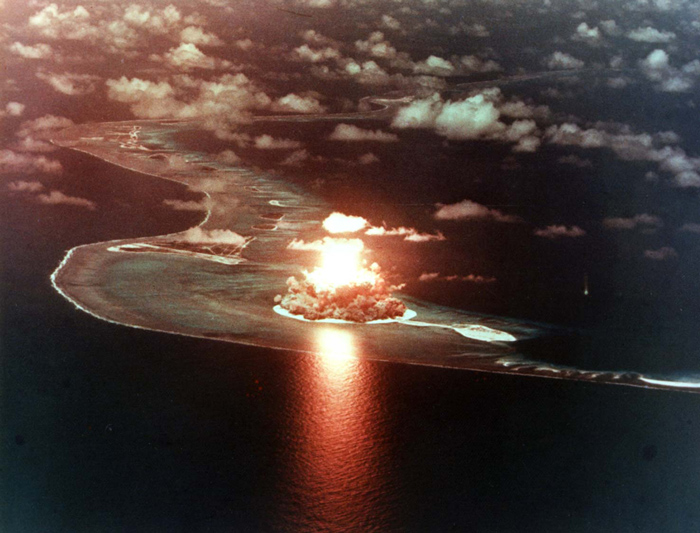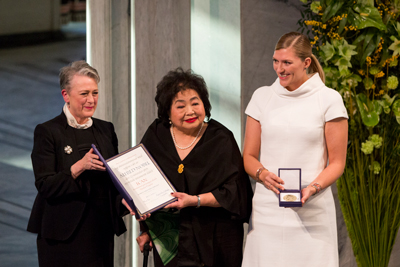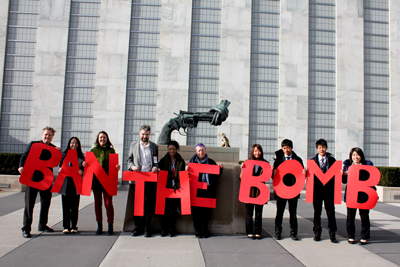Grass Roots Humanitarianism: Lessons Learned from ICAN’s Anti-Nuclear Triad
by John Miller
March 3, 2023

by John Miller
March 3, 2023

Against the backdrop of global governance’s decades-long failure to secure humanity from the threat posed by nuclear weapons, The International Coalition to Abolish Nuclear Weapons (ICAN) blazed a fresh trail toward nuclear disarmament. Leveraging three key strategies relating to its structure, message, and model, the Coalition’s work ultimately culminated in the 2017 ratification of the most comprehensive nuclear ban treaty to date.
Nuclear weapons occupy considerable space in the minds of security theorists, policymakers, and the global public. They have played a starring role in much of the past century’s geopolitical drama and the existential fear surrounding them is not overstated — their capacity for destruction remains unmatched. Worryingly, the increase in geopolitical volatility over the past decade has been reflected in the dynamics of the nuclear order. Not only has there been no attempt to bring the nuclear arms race to an end and set in motion a process of nuclear disarmament, but nuclear powers are instead in the process of modernizing and expanding their arsenals. To date, global governance and existing arms reduction treaties have utterly failed to secure the human and environmental security of the globe from the nuclear threat.

Spurred by a recognition of these failures, the International Coalition to Abolish Nuclear Weapons (ICAN) was formed in 2007 as a global coalition of civil society groups. In the years since, the Coalition has confronted the nuclear threat head-on, mobilizing international collective action on one of the fundamental global issues of our time. It has successfully reenergized the nuclear prohibition movement, gained international notoriety when it was awarded the 2017 Nobel Peace Prize, and played a crucial role in mobilizing the ratification by 91 states of the Treaty on the Prohibition of Nuclear Weapons (TPNW) — the first and only comprehensive global nuclear ban treaty to date. To achieve so much in such a short time, ICAN utilized three key strategies to refocus policymakers and the global public on the humanitarian, human rights, and environmental impacts of nuclear weapons.
The first key to ICAN’s success was its structure as a minimally hierarchical coalition of civil society groups. The decision to decentralize and democratize was not an obvious one, particularly as it related to the nature of nuclear policy: the diplomatic and military apparatuses have historically been the domain of career professionals and, particularly in the nuclear sphere, technicians. However, the decentralization, democratization, and diminished influence of hierarchy within the ICAN coalition deepened ties between stakeholders as each truly felt it had a meaningful voice and role to play. This close-knit yet global structure enhanced the Coalition’s ability to influence the perceptions and emotions of policymakers, constituents, and other actors in the policy space.
The second key to ICAN’s success was the content of the message its members’ voices carried. ICAN shifted the nuclear discourse from a historically restrictive and technical discursive space to one occurring on more universally intelligible humanitarian grounds. ICAN sought to dismantle nuclear weapons’ mystique by problematizing the idea that nuclear weapons have some legitimizing characteristic that other prohibited WMD lack. In short, ICAN claimed the possession of nuclear weapons to be incompatible with universally accepted humanitarian considerations. The Coalition took a data-driven approach toward disseminating scientific data on the harms of nuclear weapons, carefully documenting the medical, economic, political, and environmental impacts of nuclear weapons. These impacts range from the immediate blast (thermal radiation vaporizing those at ground zero accompanied by a shockwave destroying building and killing those further away) to long-term effects including environmental contamination, cancer and genetic damage.
In addition to data, the Coalition also attempted to be intentionally performative, re-emotionalizing the nuclear conversation which has been historically dry, technocratic and affectless. The shift minimized the credibility of the Cold War-era theory of deterrence and maximized humanitarian considerations, and proved crucial in introducing doubts into the minds of policymakers on positions they had assumed to be true.

The third key to ICAN’s success was its utilization of normative power, primarily through ‘naming and shaming’ tactics, to apply additional normative pressure toward nuclear prohibition and to extend the influence of the TPNW, even before its entry into force. In addition to backstopping signatories’ legal obligations, this pressure influenced non-signatories as well. The practice of naming and shaming – calling out norm violators on the international stage – has a proven record of efficacy. With a wealth of precedent in mind, ICAN launched a global nuclear divestment initiative called ‘Don’t Bank on the Bomb’ in 2012. Spurring a norm not just against states but against corporations, the initiative published an annual index of companies and financial institutions identified as being involved in the production and maintenance of nuclear weapons. As a result of this initiative and the TPNW five years later, a number of weapon manufacturers and financial institutions have stepped away from supporting the nuclear supply chain including one of the largest pension funds in the world, the Dutch fund ABP, which announced in January 2018 that it would divest from nuclear weapon production companies.
ICAN’s efforts toward a nuclear ban treaty culminated with the negotiation, ratification and entry into force of the TPNW. Negotiations took place within the UN General Assembly in the spring and summer of 2017, and the Treaty was formally adopted on July 7, 2017. The Treaty was the first, and remains the only, nuclear arms control agreement to frame nuclear weapons strictly in terms of the threat they pose to international humanitarian and human rights law.
Of the many humanitarian threats nuclear weapons pose, the Treaty specifically notes their “grave implications for human survival, the environment, socioeconomic development, the global economy, food security and the health of current and future generations” (full text available here). Crucially, the Treaty differs from prior nuclear reduction and prohibition treaties in its integration of a concrete plan for the elimination of nuclear arms, including clear steps and a verification process.
From its origin in 2005, ICAN confronted the dynamic and increasingly volatile global nuclear landscape with a new vision and approach. Beyond the unprecedented impact it has had on the nuclear discourse, ICAN has proven that landmark international agreements can have their nexus in individuals and grass roots coalitions.
The model established by ICAN – and the three strategies explored in this chapter — will hopefully galvanize similar movements to break geopolitical gridlock and reframe the public conception of key issues facing the global community. From food insecurity, migration and climate change to economic instability and widespread human rights violations, there is no shortage of crises facing the global community today.
Written by John Miller
2020 Global Governance Forum Inc. All Rights Reserved